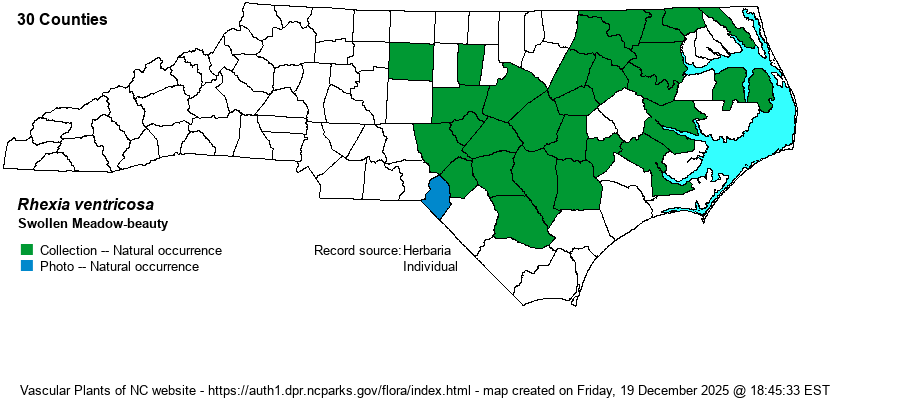| Author | Fernald & Griscom | |
| Distribution | Present over most of the Coastal Plain, but scarce to absent along the southern coast. Ranges into the eastern Piedmont, west to Guilford County.
This species has a limited range in the mid-Atlantic states, ranging from southern NJ south to eastern SC. | |
| Abundance | Generally uncommon to perhaps locally fairly common in most of the range, but apparently rare in the Sandhills. Rare to uncommon in the eastern Piedmont. Probably most numerous in the northern counties, as in VA it is considered as "Frequent" in the southern Coastal Plain (according to the Digital Atlas of Virginia Flora website). | |
| Habitat | This is a wetland species not closely tied to Longleaf Pine (Pinus palustris) habitats or other pineland habitats as are most species. It grows in bottomland or swamp openings and edges, damp roadsides, ditches, and much less often in wet pine flatwoods. One Sandhills population occurs on the margin of an impoundment lake. | |
| Phenology | Blooms from June to September, and fruits shortly after flowering. | |
| Identification | This is a fairly standard Rhexia, quite hairy overall and typically with a few branches. It reaches about 2 feet tall, and has its mid-stem region consisting of 4 flat surfaces of equal size and flatness (compared with unequally flattened as in R. mariana and R. nashii). The paired leaves are elliptic to ovate, about 2-3 inches long and about 3/4-inch wide, with small serrations along the margins. The flowers are typical for the genus, consisting of a handful of them from upper leaf axils and stem tips, with the 4 petals being rose-pink to purple-rose and the flower being about 1.5 inches across. In this species, the edges of the stem are not winged, as in R. virginica. Also, R. virginica has the roots with tubes or spongy-thickened, versus none of these for R. ventricosa. Thus, separation of these two species can be troubling, and both can occur in the same regions and wetland habitats. In general, the petals of this species are not as deeply rose-colored as in R. virginica, generally more of a rose-pink color. | |
| Taxonomic Comments | More references than not treat this taxon as a variety of R. mariana, as R. mariana var. ventricosa. However, RAB (1968) treated it as a species, though with some uncertainty, and Weakley (2018) also treats it as a good species. NatureServe does not consider it a valid species, and thus the website editors have provided a Global Rank on this species account.
| |
| Other Common Name(s) | Creeping Meadow-beauty | |
| State Rank | S3 | |
| Global Rank | G5T4T5 [G4G5] | |
| State Status | | |
| US Status | | |
| USACE-agcp | | |
| USACE-emp | | |

